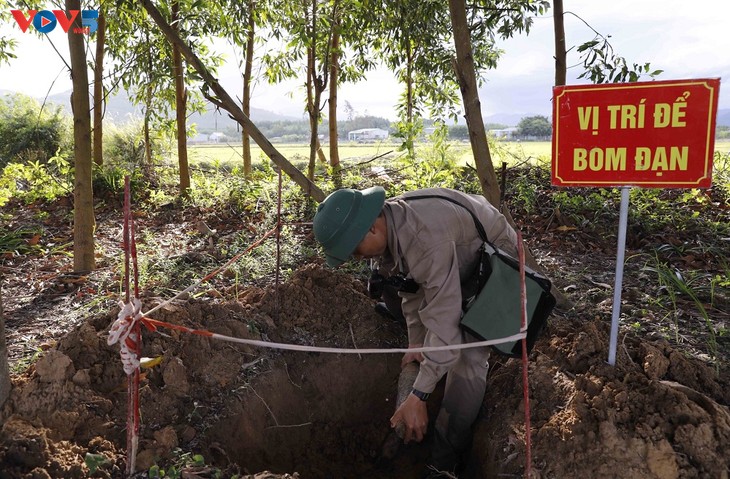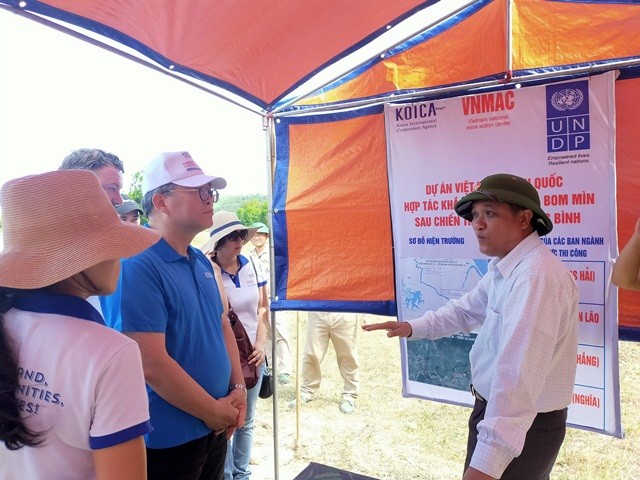(VOVWORLD) - The Korea-Vietnam Mine Action Project in Quang Binh and Binh Dinh province has achieved remarkable results in three years. By identifying contaminated areas and removing landmines and UXOs, the project has made local production, daily activities, and economic development safer for everyone.
 (Photo: Vinh Phong/VOV5) (Photo: Vinh Phong/VOV5) |
Phu Cat district in Binh Dinh province saw some of the region’s fiercest fighting during war time. Due to limited funding, the clearance of bombs, mines, and unexploded ordnances (UXO) is still far from being completed.
Since the Korea-Vietnam Mine Action Project was launched, people of Phu Cat have felt a renewed hope that their 2,000 ha of land will eventually be cleared for farming and other production activities.
Nguyen Thi Tuyet, Deputy Chairwoman of the district People’s Committee, said, “Following technical surveys and mine clearance, the project has created a large area safe for cultivation and production. Some of the land has been used to build medical stations and schools. We’ve improved the lives of 4,000 local victims of bombs and mines by creating a means of subsistence for them.”
|
 A sapper of the Korea-Vietnam Mine Action Project. A sapper of the Korea-Vietnam Mine Action Project.
(Photo: Vinh Phong/VOV5)
|
67-year-old Nguyen Thien in Phu Cat said his family and 30 other households have been moved to a decontaminated resettlement area.
Thien said his family will no longer suffer from flooding or isolation by heavy rain storms, and will feel safer while farming or doing other work.
“In the past, nobody dared to work or farm there or dig a house foundation. Many were killed or injured while digging. This project is enabling us to live safely on our own land and not feel threatened anymore,” Thien added.
The project was begun in 2018 with 30 million USD of non-refundable aid from the Korea International Cooperation Agency (KOICA) and the UNDP.
By the end of its first phase, it had surveyed nearly 17,000 ha of land and cleared bombs and mines on an area of 5,700 ha in the two provinces.
Nguyen Van Nghiep, Deputy Director General of the Vietnam National Mine Action Center (VNMAC) and the project’s Director, said, “This project is different from other VNMAC projects which only built homes, offices, roads, schools, and medical stations.”
“Under the project, all contaminated areas will be disarmed. After the first phase, from 2018 to now, we drew many lessons, from receiving the land from local administrations to surveying the land, identifying contaminated sites, removing mines, and handing over the decontaminated land to the locality,” said Nghiep.
|
 A delegation of the Vietnam National Mine Action Center, KOICA, and UNDP makes a fact finding tour to evaluate the project’s performance A delegation of the Vietnam National Mine Action Center, KOICA, and UNDP makes a fact finding tour to evaluate the project’s performance
in Quang Binh on May 26, 2020. (Photo: qbtv.vn)
|
Cho Han-Deog, KOICA Country Director for Vietnam, said the agency will continue to help Vietnam build communities free of bombs, mines, and UXOs, and turn the contaminated areas into safe production zones.
He said, “It’s impossible to complete a post-war bomb and mine clearance project in a short period of time. So we are reviewing and assessing the project’s achievements and beginning a second phase. We’ll do sub-projects on the decontaminated land to help the locals develop their economy and enjoy a better life.”
The humanitarian project in Quang Binh and Binh Dinh, one of the largest of its kind supported by foreign aid, has provided rehabilitation equipment and vocational training to victims of explosive remnants of war, and raised public awareness of the risks of mines and how to avoid accidents.
The project’s data shows that Vietnam still has more than 6 million hectares of land contaminated with mines and UXOs that survived the war.